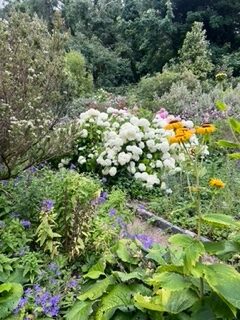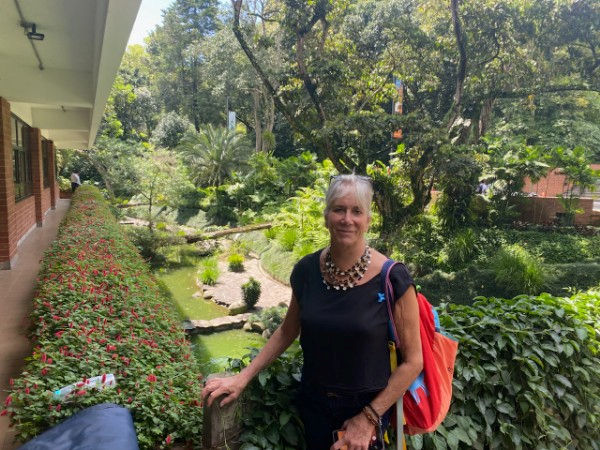by Katherine Coppedge, Fulton County Master Gardener Extension Volunteer
This article is part of Garden Buzz, a series from Appen Media and the North Fulton Master Gardeners, where rotating columnists explore horticulture topics like herbs, insects, and wildlife conservation. Find all Garden Buzz articles here.


I decided to transition my landscape to native plants because I wanted to create a habitat in my yard to promote more biodiversity. Biodiversity refers to different kinds of life in one area that work together to make an intricate web, maintaining and supporting life. Planting native plants also conserves water and reduces maintenance needs.
It has taken me several years to make these conversions in my yard. I have eliminated the lawn in my backyard, and I am gradually working on my front yard. You can start with one corner or an area of your yard and expand the scope as you desire. The following are my suggestions for adding native plants and more biodiversity to your yard.
Steps to transition to a native landscape
Assess your site
Identify drainage and sunlight exposure. Determine the nutrient levels in your soil by taking a sample to your local county extension office. All plants thrive in the right conditions, so match your plant choices with your yard’s natural characteristics. Prepare the soil, add organic material like mushroom compost, topsoil, or humus, and mix well to a depth of 6-8 inches.
Plan your design
Cluster Plants
Group similar plants together by their water and sunlight needs. Plant taller plants toward the back of the bed or planting area and shorter ones toward the front.
Layering
Use a variety of plant types, including trees, shrubs, perennials and ground covers to create a diverse ecosystem. Choose a mix of plants that provide year-round interest, such as flowering shrubs for spring and colorful berries for winter.
Select native plants
Trees
White oak, Southern red oak, Eastern red cedar, American holly, flowering dogwood, Eastern redbud, American beech, red maple, American hornbeam, Eastern white pine, black gum, Tulip popular, among others.
Shrubs
Oakleaf hydrangea, American beautyberry, sweet shrub, Southern wax myrtle, azaleas, blueberry, bottlebrush buckeye, butterfly weed, buttonbush, inkberry, or leucothoe. I removed a whole beautiful row of Fatsia and replaced it with Leucothoe in my yard.
Perennials
Black-eyed susan, Georgia aster, purple coneflower, phlox, swamp milkweed, red columbine, green and gold, Virginia sweetspire, cardinal flower, beebalm, sunflowers.
Grasses
Little bluestem, river oats, switchgrass, autumn bentgrass, southern waxy sedge.
Remove invasive, non-native species
Before planting natives, clear out invasive plants, such as like kudzu, privet, English ivy, vinca, Japanese honeysuckle, cogongrass, leatherleaf mahonia, Japanese stiltgrass and scutch grass that compete with native species.
Mulch and water wisely
Apply pine straw or hardwood mulch around the plants as needed to maintain moisture and reduce weed growth. Water wisely, in the morning or late evening, 2-3 times a week to establish. Then, water weekly as needed so that plants get about 1” of water per week.
Plant species to attract pollinators
Milkweed for monarchs, bee balm for bees, American persimmon, phlox, purple coneflowers, butterfly bush, chives, parsley.
Maintain properly
Native plants generally need less care, but they will still benefit from occasional pruning, weeding and mulching. Allow the plants to reseed and spread naturally for a fuller looking landscape over time.
Challenges
One of my personal challenges was being patient with the process. It takes time to prepare the areas you want to change and figure out which plants you want to use. Another consideration was the cost to replace my non-natives with natives. I am very happy with the results and the great biodiversity and other benefits it has brought to my yard.
Use local resources
Georgia has many organizations and plant societies dedicated to native plant gardening. Check with your county extension office or groups like the Georgia Native Plant Society for online plant lists, resources and expert advice.
North Fulton Master Gardeners and the Georgia Native Plant Society will be hosting a great plant sale and opportunity for you to learn more at Garden Faire on Saturday, April 12th, 2025, where you can choose from thousands of plants for your garden. The event is FREE from 9:00a.m.-3:00p.m. at The Grove at Wills Park, 175 Roswell Street in Alpharetta. For more information go to www.NFMG.net.
Sit back and enjoy the fruits of your labor!
By following these steps, you’ll create a thriving, low-maintenance landscape that supports local wildlife and contributes to Georgia’s ecological health.
Happy Gardening!
Learn More
- Native plant publications (University of Georgia Extension)
- Native Plants of North Georgia, a Photo Guide for Plant Enthusiasts (UGA Extension)
- Landscaping With Native Plants – Middle Tennessee (Southeast Exotic Plant Pest Council)
- List of Native Plants for Georgia (Walter Reeves)

About the Author
This week’s “Garden Buzz” guest columnist is Roswell resident Katherine Coppedge. Katherine has been a Master Gardener since 2009 and has been gardening in the Atlanta area since the ‘70s. Katherine is an avid hiker and lover of walking in the woods. Katherine is a member of the Spalding Garden Club and has been a board member of the John Ripley Forbes Big Trees Preserve in Sandy Springs since 2006. Katherine shared her love of trees and forest bathing in her Spring 2021 garden lecture “Big Trees of Sandy Springs” which is viewable at https://youtu.be/oeOlLc21ue0.